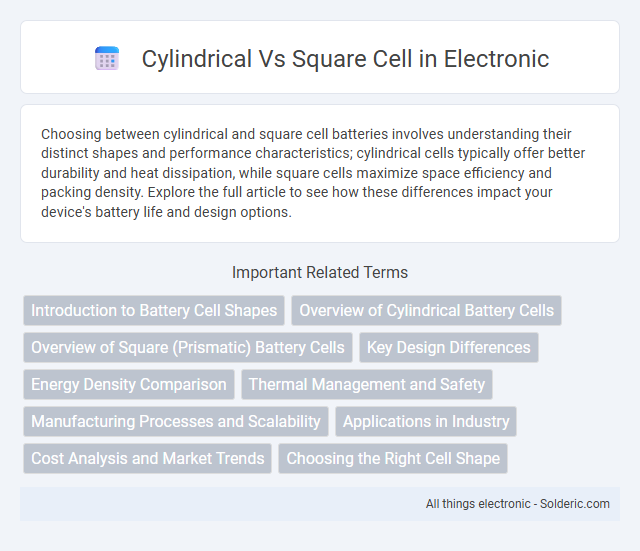Choosing between cylindrical and square cell batteries involves understanding their distinct shapes and performance characteristics; cylindrical cells typically offer better durability and heat dissipation, while square cells maximize space efficiency and packing density. Explore the full article to see how these differences impact your device's battery life and design options.
Comparison Table
| Feature | Cylindrical Cell | Square Cell |
|---|---|---|
| Shape | Round, cylindrical | Rectangular, square-edged |
| Energy Density | Moderate to high | High |
| Thermal Management | Better heat dissipation | More prone to overheating |
| Manufacturing Cost | Lower | Higher |
| Durability | Robust due to metal casing | Less robust, sensitive to swelling |
| Applications | Power tools, laptops, electric vehicles | Smartphones, tablets, electric vehicles |
| Form Factor Efficiency | Less space-efficient packing | More efficient space utilization |
Introduction to Battery Cell Shapes
Battery cell shapes significantly impact energy density, thermal management, and packing efficiency in devices. Cylindrical cells offer robust mechanical stability and effective heat dissipation due to their round design, making them ideal for electric vehicles and power tools. Square cells provide higher space utilization and flexibility in battery pack assembly, commonly used in smartphones and laptops for maximizing internal volume.
Overview of Cylindrical Battery Cells
Cylindrical battery cells feature a round, tubular shape that enhances structural integrity and efficient heat dissipation, making them ideal for high-drain applications. These cells typically offer consistent performance, longer cycle life, and easier automated manufacturing compared to square cells. Your choice of cylindrical cells can improve energy density and reliability in devices like power tools, electric vehicles, and laptops.
Overview of Square (Prismatic) Battery Cells
Square (prismatic) battery cells feature a compact, rectangular design that maximizes space efficiency in devices and electric vehicles. Their rigid metal casing provides enhanced structural integrity and better heat dissipation compared to cylindrical cells. You benefit from higher energy density and easier packaging flexibility, making prismatic cells ideal for applications demanding optimal power-to-size ratios.
Key Design Differences
Cylindrical cells feature a round shape with a metal can and typically offer higher energy density and better thermal management due to their uniform surface area. Square cells, also known as prismatic cells, have a rectangular form factor that allows for more efficient space utilization and easier stacking in battery packs. Your choice depends on balancing energy density needs with pack design flexibility and cooling requirements.
Energy Density Comparison
Cylindrical cells typically offer higher energy density due to their efficient thermal management and structural stability, allowing for more active material per unit volume. Square cells provide a better space utilization within battery packs but usually have slightly lower energy density because of increased surface area and potential heat dissipation challenges. Your choice of cell format impacts the overall energy storage capability and thermal performance of the battery system.
Thermal Management and Safety
Cylindrical cells offer superior thermal management due to their uniform surface area, which promotes efficient heat dissipation and reduces hotspot formation, enhancing overall safety during high discharge and charge cycles. Square cells, while space-efficient, often face challenges in heat distribution because of their flat surfaces and tight stacking, increasing the risk of thermal runaway if cooling systems are inadequate. Your choice between these cell types should consider the balance between thermal stability and safety requirements for your specific battery application.
Manufacturing Processes and Scalability
Cylindrical cells are produced using automated winding techniques that enable high-volume, cost-effective manufacturing, making them ideal for large-scale applications like power tools and electric vehicles. Square cells utilize stacked layers of electrodes, which offer more flexibility in size and shape but require more precise assembly and quality control, impacting scalability and production speed. Understanding your application needs will help determine whether the efficient mass production of cylindrical cells or the design adaptability of square cells aligns better with your manufacturing goals.
Applications in Industry
Cylindrical cells are widely used in power tools, electric vehicles, and laptops due to their robust design and efficient heat dissipation, making them suitable for high-drain applications. Square cells, commonly found in smartphones, tablets, and wearable devices, offer space efficiency and higher energy density, optimizing your device's compact design. Both cell types serve crucial roles, with industry choice driven by specific performance and form factor requirements.
Cost Analysis and Market Trends
Cylindrical cells generally offer lower production costs due to standardized manufacturing processes and widespread use in applications such as power tools and electric vehicles, leading to economies of scale. Square cells, preferred in portable electronics for their higher energy density and efficient space utilization, often incur higher material and assembly expenses, impacting overall cost. Market trends indicate increasing investments in square cell technology driven by consumer electronics growth, while cylindrical cells maintain strong demand in automotive and industrial sectors due to cost-effectiveness and reliability.
Choosing the Right Cell Shape
Choosing between cylindrical and square cells hinges on application requirements such as energy density, manufacturing cost, and thermal management. Cylindrical cells offer high durability and better heat dissipation, making them ideal for power tools and electric vehicles, while square cells maximize space efficiency in devices like laptops and smartphones. Optimal cell shape selection balances factors like volumetric efficiency, assembly complexity, and thermal performance to enhance battery life and safety.
Cylindrical vs Square cell Infographic

 solderic.com
solderic.com